Accepted Scientific Name: Pachypodium horombense Poiss.
Bull. Acad. Malgache 1922-3, n. s. vi. 165 (1924), in obs. et in adnot.
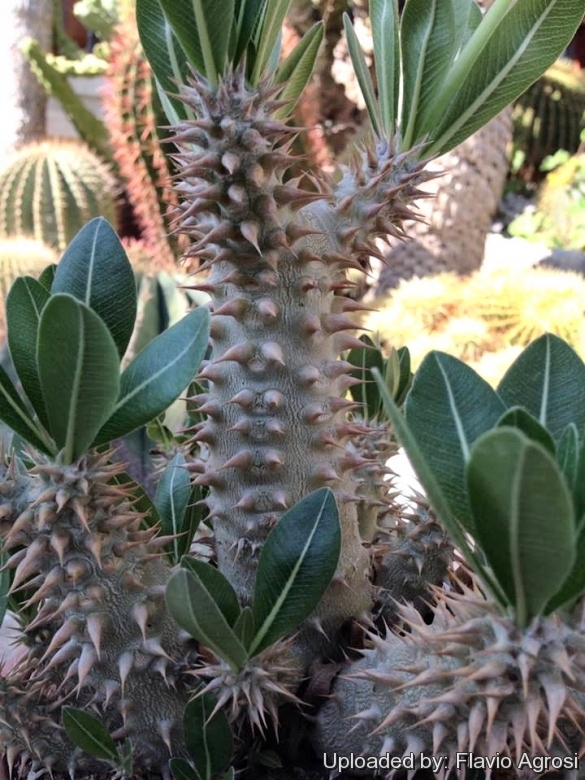
Pachypodium rosulatum var. horombense (Pachypodium horombense) Photo by: Flavio Agrosi
Origin and Habitat: Horombe plateau in southern Madagascar.
Type locality: Madagascar, Fianarantsoa, Ambatolahy-Kelivondraka Road,
Altitude range: 500-1000 metres above sea level.
Habitat: It is found in granite outcrops on hilltops, which are also home to some of Madagascar's rarest species, for example Pachypodium brevicauleSN|11689]]SN|11689]], Euphorbia quartziticola, Aloe calcairophylla, Aloe isalensis and Schizolaena tampoketsana.
Synonyms:
See all synonyms of Pachypodium horombense
back
Accepted name in llifle Database:Pachypodium horombense Poiss.Bull. Acad. Malgache 1922-3, n. s. vi. 165 (1924), in obs. et in adnot.Synonymy: 3
back
Common Names include:
ENGLISH: Horombe Clubfoot, Yellow Bell Pachypodium
CHINESE (中文): 筒蝶青
KOREAN (한국어): 호롬벤세
LITHUANIAN (Lietuvių): Šakotasis tukvis
Description: Pachypodium horombense is a succulent shrublet about 1.5 m high with a plump, bottle-shaped, main stem surmounted by a number of short, spiny fat arms each bearing a rosette of leaves and a single long-peduncled inflorescence that carries 3-10, broadly cup-shaped, horizontal, gold flowers during the warm months of the year. The flower has an inflated corolla that forms five large sacs into which the pollinator can crawl. Unless in flower, it's difficult to distinguish it from the cactus pachypodium (Pachypodium rosulatumSN|14782]]SN|14782]]).
Habit: P. horombense is a succulent shrub or dwarf tree up to 60 cm high similar to Pachypodium rosulatum but with stiffer, more erect stems branching nearer to the base.
Stem: The cactus-like trunk and branches are covered with short paired spines. A plump tuberous base often called a caudex 50-70 cm in diameter, is also present, it is a swollen trunk-root transitional area that stores water. Trunk, 20-30 cm in diameter; bark grey-green, shiny, smooth, medium green, wood cream. Branches up to 10 cm in diameter; branchlets 20-40 cm long and 6-20 mm in diameter, not linear but variously twisted, bent and gnarled, covered with paired straight spines, 3-10 mm long, 1-3 mm in diameter at the base, basal part conical.
Leaves: Thick, stiff, subsessile in a whorled tuft on branch tips elliptic to narrowly oblong 25-80 mm long 5-20 mm broad rounded at the apex, wedge shaped at the base. Petiole 1-3 mm long, pubescent. Deep green, glossy, with a pale green or yellowish midvein and secondary veins above and felted, white undersides with again paler midrib and dark green reticulate venation. Papery when dried. Completely deciduous in winter As temperatures cool and soil dries out in the tropical winter, the foliage drops away.
Inflorescence: 4-11-flowered an an upright pubescent, peduncle, 10-60 cm tall, 3-8 mm wide. Pedicels 5-45 mm long, pubescent. Bracts pale green, oblong to obovate, 8-25 mm long 2-6 mm wide, acuminate at the apex sometimes hidden by the hairs.
Flowers: Chrome-yellow. Sepals pale green, fused at the base for about 0.5 mm, ovate 6-15 mm long 2-4 mm broad, acuminate at the apex, pubescent outside, glabrous inside. Tube broadly cup-shaped, 17-23 mm in diameter, 5-lobed in cross-section with dark red longitudinal lines in bud, pale green in open flowers. Corolla bright yellow, 2.5-5.5 cm long in the mature bud and forming a comparatively wide ovoid head. Basal part almost cylindrical, abruptly widened where the stamens are inserted into the upper part which is urceolate, 18-40 mm long, 15-26 mm wide at the mouth, with 5 again widened parts below the lobes and therefore 5-winged inside; lobes obliquely and broadly obovate.
Blooming season: During the warmth and increased moisture of late spring and into summer, thin flower stalks tower above the leafy branch tips.
Fruits: 14 cm x 7 mm.
A wild hybrid has been recorded with Pachypodium densiforum.
Subspecies, varieties, forms and cultivars of plants belonging to the Pachypodium horombense group
Bibliography: Major references and further lectures
1) S. H. J. V. Rapanarivo “Pachypodium (Apocynaceae)” CRC Press, 01/Jun/1999
2) Werner Rauh “The Wonderful World of Succulents: Cultivation and Description of Selected Succulent Plants Other Than Cacti” Smithsonian Institution Press, 1984
3) G. D. Rowley: Pachipodium. In: Urs Eggli: "Illustrated Handbook of Succulent Plants: Dicotyledons." Springer Verlag, 2002
4) Perrier de la Bathie, H.. “Les Pachypodium de Madagascar.” in: Bull. Soc. Bot. France 81: 297–318. 1934
5) Rapanarivo, S. H. J. V. & A. J. M. Leeuwenberg. “Taxonomic revision of Pachypodium. Series of revisions of Apocynaceae XLVIII.” in: Rapanarivo, S. H. J. V. et al., "Pachypodium (Apocynaceae): taxonomy, habitats and cultivation." 1999.
6) Rowley, G. “Pachypodium & Adenium.” in: Cactus File 5: 1-79. 1999
7) Rowley, G.D. "The Pachypodium rosulatum aggregate (Apocynaceae) - one species or several?" Bradleya: The British Cactus and Succulent Society Yearbook. (16/1998)
8) Lüthy, Jonas M. "Another look at the pachypodiums of Madagascar." Bradleya: The British Cactus and Succulent Society Yearbook. (22/2004)
9) Eggli U., Newton L.E. & Rowley G.D., "CITES Aloe and Pachypodium Checklist" Board of Trustees of the Royal Botanic Gardens, Kew, 2001
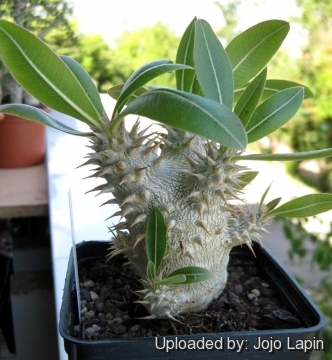 Pachypodium rosulatum var. horombense (Pachypodium horombense) Photo by: Jojo Lapin
Pachypodium rosulatum var. horombense (Pachypodium horombense) Photo by: Jojo Lapin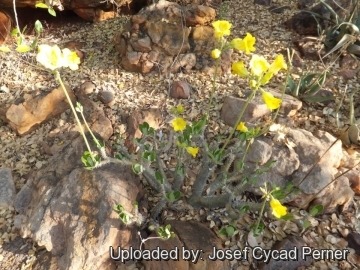 Pachypodium rosulatum var. horombense (Pachypodium horombense) Photo by: Josef Cycad Perner
Pachypodium rosulatum var. horombense (Pachypodium horombense) Photo by: Josef Cycad Perner Pachypodium rosulatum var. horombense (Pachypodium horombense) Photo by: Josef Cycad Perner
Pachypodium rosulatum var. horombense (Pachypodium horombense) Photo by: Josef Cycad Perner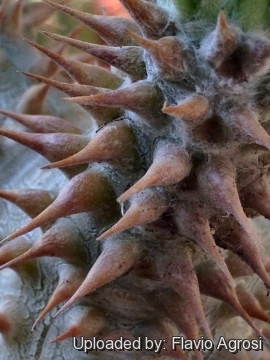 Pachypodium rosulatum var. horombense (Pachypodium horombense) Photo by: Flavio Agrosi
Pachypodium rosulatum var. horombense (Pachypodium horombense) Photo by: Flavio Agrosi Pachypodium rosulatum var. horombense (Pachypodium horombense) Photo by: Josef Cycad Perner
Pachypodium rosulatum var. horombense (Pachypodium horombense) Photo by: Josef Cycad Perner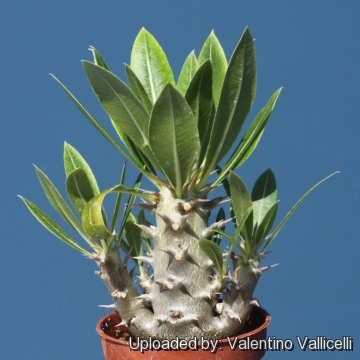 Juvenile seedling. (Pachypodium horombense) Photo by: Valentino Vallicelli
Juvenile seedling. (Pachypodium horombense) Photo by: Valentino Vallicelli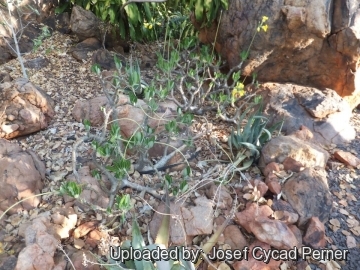 Pachypodium rosulatum var. horombense (Pachypodium horombense) Photo by: Josef Cycad Perner
Pachypodium rosulatum var. horombense (Pachypodium horombense) Photo by: Josef Cycad Perner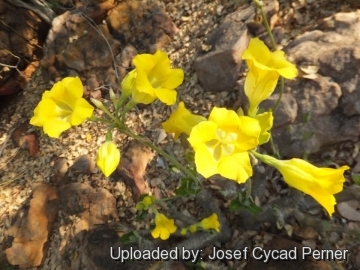 Pachypodium rosulatum var. horombense (Pachypodium horombense) Photo by: Josef Cycad Perner
Pachypodium rosulatum var. horombense (Pachypodium horombense) Photo by: Josef Cycad PernerCultivation and Propagation: Pachypodium horombenseSN|14793]]SN|14793]] is one of the most attractive species in the entire genus that can be grown both indoors, as well as outdoors in warm climates. It’s a moderate grower and an impressive caudex can be steadily developed. In the winters it is deciduous, except in very tropical areas. Pretty cold sensitive- supposedly prone to rot if wet in winter cold. It may be grown as a specimen among rocks and low-growing plants in a hot rockery. It may also be grown in a heavy container on the sunny patio.
Soil: Needs a gritty, porous cactus potting mix that's not strongly acidic.
Watering: Water sparingly in the heat of the growing season to encourage new growth, foliage and flowering, and give extra well-drained soil to avoid waterlogged conditions, no water from late autumn to mid-spring. The watering program will change depending on temperatures and stage of growth, but it is best not to let this plant dry out completely for any length of time. Indoors it is best to keep it on the dry side, or it is prone to rot. Outdoors it must be protected from the rain in winter. Do not let this specimen sit damp in cool weather. The older it gets the less water it must receive!
Hardiness: It is sensitive to cold and should be kept totally dry in winter at or around 10°C, but it demonstrates some cold resilience if dormant and the soil is bone dry in winter. Protect from frost. It tends to lose its leave and go dormant in winter (USDA Hardiness zones: 10 – 11).
Exposure: It like full sun to light shade.
Maintenance: This Pachypodium will not require any pruning to look like a very interesting and unusual bonsai, but after several years it can outgrow its indoor location, requiring a 'pruning'. It has amazing regenerative properties.
Repot: Repot the plant every 3 years; this is quite tricky given all the spines. The best way is to wrap several layers of newspaper around the trunk where it is to be handled.
Warning: This plant has spines use caution when handling.
Propagation: Seeds or (rarely) cuttings. Fresh seeds results in a remarkable yield of new plants, perhaps 90% and seedlings grow fairly easily. Soak seeds in warm water for 24 hours before sowing in a 5 mm deep, sterile, moist sandy medium (4 parts fine and 4 parts coarse river sand 1 part sieved, well-rotten compost; 1 part perlite; 1 part vermiculite. Keep the mix moist and at a temperature of 27–35°C to ensure rapid germination. Seed start sprouting in just 3-4 days ( but continue to germinate erratically for about 6 month) they are also propagated by removal of branches from old plant (if they need to be pruned). They should be allowed to dry for 5 to 8 days before potting up, however the cuttings often fail to root. Seedlings grow fairly slowly compared to other Pachypodium species. Young plants have more conical spines and begin early to swell nicely, branch and even flower.
Your Photos

by Giuseppe Distefano



















